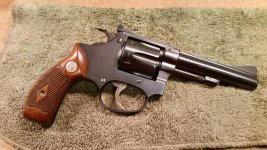Hi Bill,
Jack above has ID'd your Kit Gun accurately. "Model of 1953 22/32 Kit Gun" built on the New I frame forging with larger trigger guard, coil main spring, and 1/8" longer grip frame than previous models.
Your # 765 most likely shipped ~in the 3rd quarter of 1954. It came in the red box.
Much more detail on page 144 of the SCSW, 4th ed. if you have it or here:
http://smith-wessonforum.com/blog.php?b=103
It's numbered as follows:
SERIAL # LOCATIONS: To confirm all parts are original, one can check for the 6 (or 7, on Triple Locks only) matching serial # locations for fixed sight pre war Hand Ejectors and all post war Hand Ejectors thru ~1956 (and a few as much as 3 years later).
NOTE: Observing serial #s for accuracy or even existence, especially on penciled stocks, requires magnification, bright light, and an attitude that it is there!
1. Gun butt – (or fore strap on I frames/single shots with grips that cover the butt)
2. Barrel - bottom of barrel or in extractor shroud
3. Yoke - on rear face only visible thru a chamber with a flashlight
4. Extractor star - backside
5. Cylinder - rear face
6. Right stock only - on back, (except most post war target stocks because individual fitting not required); stamped, scratched or penciled depending on vintage and stock material.
7. Triple Locks only: rear side of middle lock cam plate
ASSEMBLY (factory work) #s: These multi-digit numbers of 3 to 5 digits, are on the yoke at the hinge, in the ‘yoke cut’ on frame (accompanied with a stamped inspector letter) opposite the yoke above the hinge, and inside of the sideplate, for the pre war and early post war period. Once the gun is shipped, the only use for the assembly #s is to confirm the three parts it's stamped on are original. They will have various inspector letters stamped with them.
In 1957 the assembly # in the yoke cut of the frame was relocated to the left side of grip frame after model #s were assigned and the serial # was eventually added in the ‘yoke cut’ where the assembly #, now moved to the left side of the grip frame, used to be. You know they are assembly (factory work) #s because of those 3 locations that always match on guns that are original, and that’s the only usefulness for them after guns leave the factory; still used to this day, long after serial number locations decreased.



